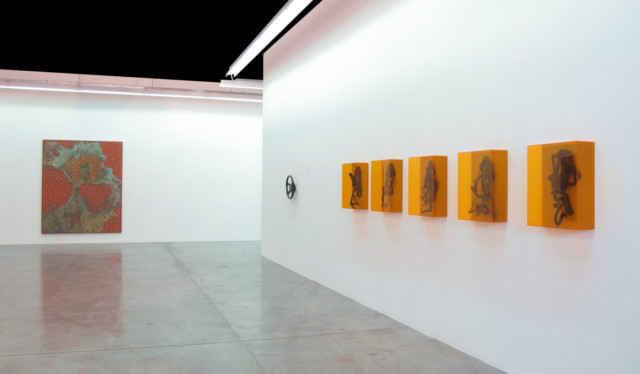
Well-known Portuguese sculptor Rui Chafes works with steel. But despite the industrial material and processes he uses, his black shadowy sculptures convey a feeling of lightness. On the other hand, German artist Ralf Ziervogel’s drawings are composed of delicate, barely visible lines, but embedded within them is the weight of intense emotions. Their joint exhibition, “Black Rainbow” invites viewers to look beyond the obvious and to contemplate the contradictions, complexities and ironies of modern life.
Ziervogel’s previous work featured figurative drawings on paper, depicting scenes of graphic brutality and violence. The simple monochromatic drawings of geometric shapes on canvas in his latest series look very different. But a closer look with a magnifying glass reveals that the explosion of fine lines on his canvases are in fact composed of tiny handwritten words expressing aggression, thus presenting a verbalised version of the visuals in his earlier work.
The words hidden within the lines relate to various obsessive behaviours that speak about the fragility of the human mind, the inner turmoil hidden behind our calm exteriors and our desperate attempts to stay sane when confronted by the real and virtual worlds. In a set of paintings, titled “Kobold”, Ziervogel references the fictional character’s obsessive hatred for Spiderman with words such as “I will Kill You” and “I will rip you apart” repeated over and over in the lines. In the “Eskimolied” series the lines on gesso-primed canvas in some paintings appear like tracks in the snow. The miniature words in the lines allude to the chants that Inuits sing to themselves to avoid going crazy. In other works, expletives in English and German are evocative of Tourette’s syndrome, an ailment that makes people uninhibitedly verbalise their dark, hidden thoughts in public. Ziervogel’s iPad-sized drawings on paper, called “Eskimolied (More)”, are filled with frantic thumbprints and palm prints. They resemble the screen of a much-used iPad, commenting on our obsession and frustration with modern gadgets and “being connected”.
Chafes also plays with words in his work. “The words in the titles of my sculptures trigger images, thoughts and memories through which viewers can relate to them,” he says. All the sculptures in this show are inspired by cultural icons from various artistic fields. “Inferno XXX” is inspired by Italian master Botticelli’s work. The wall-mounted piece featuring a cascade of wavy black steel strips references the flowing, curly hair of the women in Botticelli’s paintings. But when viewed upside down it appears like the rising flames in the artist’s illustrations for Dante’s “Inferno”. “The Dream of Girogio de Chirico” is a work from a series inspired by the work and words of the metaphysical artist. Suspended from the ceiling, the nebulous sculpture represents an abstract portrait of the artist, referencing the mannequin heads Chirico painted in the 1920s. Similarly, “Tati” is a poetic, abstracted tribute to French director Jacques Tati. The form resembles the humorous gesticulations of Tati’s alter-ego “Monsieur Hulot”, but his presence is suggested merely by what looks like a balloon or perhaps a soap bubble being blown.
“Chirico was a painter of impossible shadows. I have stolen his ideas and words to create these mysterious floating forms. And in ‘Tati’, you see not him, but his absence. This sculpture is a ‘monument to absence’. I use iron and steel because they are materials connected with modern times and are all around us in different forms. I like the idea that iron comes from the Earth and is forged with fire, and has a complex history ranging from its use in agricultural tools that feed people to weapons that kill. But although I use this hard, heavy industrial material, my aim is to create works that evoke the fragility of a bubble, a shadow-like quality and a feeling of floating. I always cover the shiny steel with a final coat of matte black or grey to create that shadowy effect. These are not objects, but ideas that are catalysts for thoughts and memories,” he says.
“Black Rainbow” will run at Carbon 12 until March 10.
Box:
Mutajadid
By Jyoti Kalsi
Emerging Emirati artist Maitha Demithan is presenting a series of experimental installations and new media works in her latest show, Mutajadid, curated by Dr Alexandra MacGilp. The artist is known for her scanography portraits, where she uses an A4 flatbed scanner to record the surface of figures and objects, which she puts together to create poetic, layered images of graceful floating figures. “I see this technique as a way of painting with light. The multiple layers of construction and deconstruction in these portraits are a contrast to our prevailing Instagram culture. And I want to invite viewers to project their own memories and associations on my fantasy figures,” she says.
The artist has experimented with new techniques and subjects in this show, and is presenting projections, installations, a video and transfers on cloth. Her subjects are usually her friends and family. But in the new series, her focus is on birds and garments. In some works she has used a video camera to photograph the contours of a falcon’s body, presenting the feathers, leather hood and scaly feet of a bird that is a part of Emirati culture in an abstract, unrecognizable form.
The inspiration from Emirati culture is also visible in her “portraits” of traditional garments. These include her cousin’s childhood dresses from the 1980s and her mother’s burqa. Representing their owners, these garments carry memories and traces of personal and cultural history.
“The multiple layers in my portraits reflect the fact that there are multiple identities within us, and there is no one true identity. I try to capture a subject’s personality and appearance, but it is impossible to ever truly represent them,” she says.
“Mutajadid” will run at Tashkeel until February 27.











